Keynote Address, June 16, 2004 Silverdocs Seminar, co-sponsored by the World Bank, Washington DC.
The Times of India,
26 June 2005
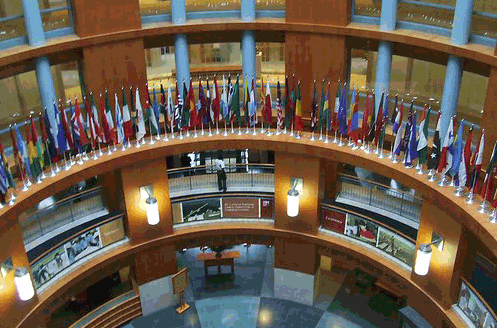
In 2004 Anand was invited by The Silverdocs International Film Festival in Washington DC to give a keynote address at a seminar co-sponsored by the World Bank. Guests and speakers from a wide range of countries attended. The Iraq War was a year old and President George Bush Jr. was seeking re-election based on his claims of victory in the “war against terror”. Anand’s talk was interspersed with images and video clips, one of which is posted here at the conclusion.
The Messengers of Bad News
When I was invited to make this keynote presentation the most daunting but also the most tempting circumstance was the nature of the audience I would be addressing. It isn’t every day that someone like me gets to speak to decision makers and gate keepers from the North and the South, as well as filmmakers and film users from across the world.
I won’t dwell on things like High Definition, as I’m convinced that people from the developing world take no time to catch up with new technologies once these become affordable, as we witnessed with the DV revolution.
The real issues of the information gathering and disseminating systems have more to do with what kinds of programs are made, who makes and airs them and what impact they have.
The role of the developed world as consumer and the role of the developing world as the consumed may now be complicated as the latter yields its own voracious elite, but the former continues to determine taste.
In all this, those who originally set out to highlight and try to undo the injustices of the world find themselves marginalized and out of date unless they have the chutz pah and the marketing genius of a Michael Moore.
In many parts of the world, including I am afraid in America, these woes are further compounded by censorship, both overt and covert, and its more insidious sibling, self-censorship.
And yet the voices of resistance have not altogether disappeared. My keynote will discuss the need to bring them out of the margins.
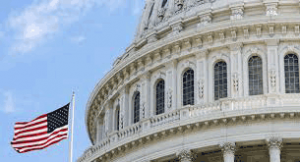 Let me be frank. For many years now whatever I’ve experienced on the ground and all the reading and research I’ve come across leads me to the belief that I stand right now in the camp of the enemy.
Let me be frank. For many years now whatever I’ve experienced on the ground and all the reading and research I’ve come across leads me to the belief that I stand right now in the camp of the enemy.
Of course the fact that I am here at all must mean that within the enemy camp there are obviously some friends. In any case I am an unworthy but ardent admirer of Gandhi. And so cannot see individuals as the enemy, but only institutions. And believe that enemies need not be forever. And that dialogue is the way forward. So here is the attempt at dialogue, illustrated by a few film clips and photographs. The material isn’t representative or comprehensive as my time slot prevents a more detailed approach and my access is limited by the same global forces that prevent all of us from seeing more such images in the normal course of our lives.
The first clip is from a film we began in 1983. At that time India was just opening its doors to foreign capital. The city of Bombay was on a beautification drive and the first victims were the homeless.
4 mins excerpt from “Bombay Our City” (1985)
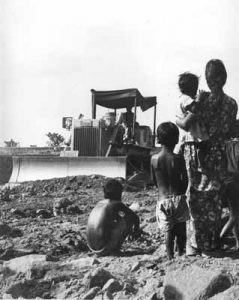
(In the clip an angry slumdweller whose home has just been demolished accuses the filmmakers of exploiting images of poverty and injustice without being able to alter conditions in any way)
I chose this clip in part to reassure those who may have been upset at being addressed as the enemy that I was referring also to the enemy within. As a member of the Indian intelligentsia I know that all my good intentions don’t by themselves ensure that my work rises above voyeurism and becomes useful to the people I filmed. Bombay Our City made its share of noise in India and even won a national award for Best Documentary but the huts of the homeless continued to be demolished. We joined a movement for the Right to Shelter. After one of the slums we had filmed in was razed, some slum-dwellers and myself went on an indefinite hunger strike to demand resettlement. The following day a famous Bollywood star Shabana Azmi, who had seen Bombay Our City joined our hunger strike. We became front page news overnight. Within 5 days the government gave in and the evicted were granted an alternate site. But for the majority of slum-dwellers inhuman conditions persisted and our film made no perceptible difference.
Later we took Doordarshan, our national TV, to court for refusing to telecast Bombay Our City. After 4 years the Bombay High Court upheld my right to freedom of speech and the public’s right to information and ordered the national channel to screen the film. We won four more court cases over the years to get my films screened on national TV. They were shown unannounced and grudgingly but it was symbolically important and aroused hope at the time.
Today this hope feels like a mirage. The logic of globalization – the empowerment of the elite and the pauperization of the poor has ensured that today’s India is even less hospitable to the working poor than before.
By the mid 80’s our focus on the rights of workers shifted to the task of combating fundamentalism. The end of the Cold War should have ushered an era of peace and prosperity. Instead we saw the USA increase its militarist posture and we also saw a global increase in religious fundamentalism. If you stop to think about it, the two things are not unconnected but that’s another story.
Meanwhile in Ayodhya in Northern India, Hindu fundamentalists tore down a 16th century Muslim mosque, claiming it as the birthplace of the Hindu God Ram. It led to nation wide carnage and the tremors from this act still reverberate.
4 mins excerpt from “In the Name of God”(1992)
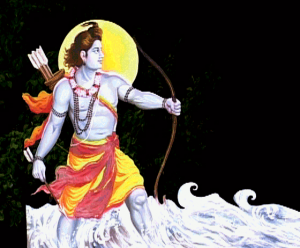 (In the clip a Hindu militant en route to demolish the Babri Mosque states that the murder of Mahatma Gandhi was perfectly justified as Gandhi had betrayed the cause of the Hindu majority)
(In the clip a Hindu militant en route to demolish the Babri Mosque states that the murder of Mahatma Gandhi was perfectly justified as Gandhi had betrayed the cause of the Hindu majority)
Our film was made before the demolition of the Babri mosque and should have alerted the nation to the hatred and carnage that would inevitably follow. But films like these remain grossly under-utilized in a nation divided by the politics of hate.
The 80’s and 90’s not only brought us religious violence. They also brought the dream of development. It was a dream that would carefully hide from everyone except its immediate victims, the price of this development. It was a dream that came wrapped in the flamboyant and seductive rhetoric of a world economy that was neither actually free nor actually democratic.
6 mins excerpt from “A Narmada Diary” (1995)
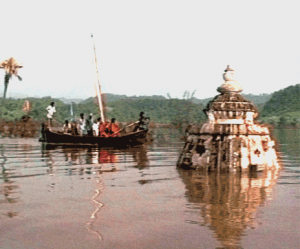 (In the clip members of the “Narmada Bachao Andolan – Save Narmada River Movement” confront officials of the World Bank and ask them to stop funding the project)
(In the clip members of the “Narmada Bachao Andolan – Save Narmada River Movement” confront officials of the World Bank and ask them to stop funding the project)
To be fair, the World Bank, having kick-started the Sardar Sarovar Dam, did attempt to rectify its mistake. The independent Morse Commission paid heed to the voices of the displaced and finally the Bank pulled out. But the damage had been done. Today in the face of mounting evidence that this dinosaur is completely unsustainable, the Indian government continues to finance its folly. The only lesson our politicians and project builders have learnt is that large projects mean large kickbacks. So now the great new game in India is a multi-billion dollar, thoroughly improbable project to inter-link our rivers.
How could all this happen? My view is that it has to do with the near absolute ideological control that is exercised over the global media. The images the world needs to see, the facts it needs to hear, are often doctored or suppressed. Let us look at some:
Images you didn’t see
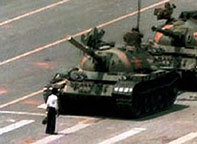
1. Tiannamen Square
This image of an unknown Chinese student stopping tanks during the pro-democracy movement at Tianamen Square in 1989 was flashed all over the world and rightly became one of the most famous symbols of heroic non-violent resistance.
2. Rachel Corrie

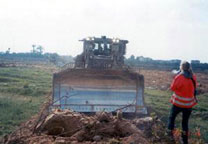 This image shows Rachel Corrie an American peace activist, trying to stop an Israeli bull-dozer from demolishing Palestinian homes. Unlike the tanks of Tiananmen, the bulldozer did not stop. It crushed Rachel Corrie to death. Unlike the images of resistance of the Chinese student, images of Rachel Corrie’s heroism and sacrifice were never highlighted long enough to register on the conscience of the world.
This image shows Rachel Corrie an American peace activist, trying to stop an Israeli bull-dozer from demolishing Palestinian homes. Unlike the tanks of Tiananmen, the bulldozer did not stop. It crushed Rachel Corrie to death. Unlike the images of resistance of the Chinese student, images of Rachel Corrie’s heroism and sacrifice were never highlighted long enough to register on the conscience of the world. Let us move from an act of omission to an act of commission.
Let us move from an act of omission to an act of commission.
3. Saddam Statue
These close up and mid shots of jubilation in Baghdad during the famous toppling of Saddam’s statue were globally broadcast giving the world the visual impression that Saddam was hated by the general population of Iraq and American troops were widely welcomed as saviours.
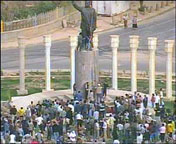
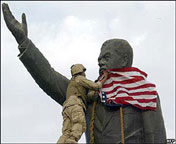
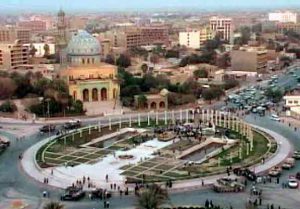 A much less publicized long shot of the same sequence gives the real story. The square is almost deserted. The statue is being pulled down not by ordinary Iraqi citizens but by ropes attached to an American armoured car. The handful of people at the square are mostly directly connected to the Occupation forces.
A much less publicized long shot of the same sequence gives the real story. The square is almost deserted. The statue is being pulled down not by ordinary Iraqi citizens but by ropes attached to an American armoured car. The handful of people at the square are mostly directly connected to the Occupation forces.
There is another great lie embedded in the incident of the Saddam statue. The US flag that was draped over the face of Saddam’s statue was the flag that purportedly fell from the World Trade Center. Thus although no proof of any connection between Saddam and Al Quaeda or any of the suspected perpetrators of 9/11 has ever been furnished, a non-verbal connection was established by the US army and the media. Such subliminal messages go a long way to explain why 80% Americans still believe that Saddam was directly or indirectly responsible for 9/11.
When I spoke of the enemy it was not because of race or culture although racism and civilizational arrogance remain alive and well in the corridors of power and in the media.
A few obvious examples. Hollywood in the name of historic authenticity recreated every lash and gash suffered by Jesus Christ but neglected to nail the lie that Jesus was a white man.
It remains hard to switch on my TV screen without spotting Anglo Saxons traipsing through Africa or Asia explaining to me its dark secrets. In contrast, despite the fact that there is no shortage of cinematic and intellectual competence in the developing world, parachute reporters from the North still dominate the spaces where our stories are told.
The truth is that not only is the North not letting us tell our own stories, it is not lettinganybody tell the stories that matter. Like the story of why Rachel Corrie died. Or why Mr.Kelly, the British government’s arms expert died. What happened to the weapons of mass destruction? Where are the stories about War and Oil and the 20,000 tons of Depleted Uranium that have been dropped on Iraq?
During the Cold War it was said that an iron curtain prevented information from getting in or out of the Communist Bloc. Today a velvet curtain of mindless infotainment envelops the globe enforcing a strict censorship of the vital stories of our times.
In the face of this disconnect many people and institutions genuinely believe they are bringing development to the world – in the same way perhaps that the USA believes it is bringing democracy to Iraq. Both these sets of beliefs are possible because of the circuitous nature of the information paradigm. You hear what you want to hear. Your filters are clogged with the residue of the horrors they have filtered out. Once in a while the flash of an American soldier gloating over the mutilated corpse of a prisoner shocks the nation and the world into questioning its core beliefs but soon the spin doctors are back in action. Soon we are told that what we thought of as torture was only “prisoner abuse”done after all for “enduring freedom”.
Whom does this filtering process hurt the most? Who will pay the price of killing the messenger of bad news? Who will remain bewildered by the fact that increasing numbers of people in the world no longer believe in the good guys riding under the Star Spangled Banner?
If international bodies like the World Bank and the United Nations remain so eternally grateful that their head offices are located on the soil of America that they find it impossible to hold the USA responsible for any wrongdoing, how can they retain credibility in the eyes of the world?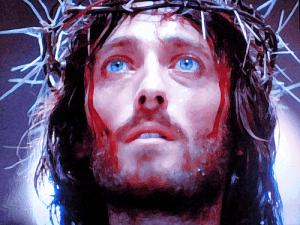
I was lucky to have studied in America in 1970. The anti-Viet Nam war movement was at its peak. I saw a people full of hope and passion for peace and justice and was infected. I see young Americans today who still retain these values. There are many but I will single out someone I have never met – William Rivers Pitt. He started a website called Truthout.org that tells you Everything you Wanted to Know about the War on Iraq but were Afraid to Ask.
He said this in a recent article:
“Our corruption is the absolute triumph of image over reality, of flash over substance, of the pervasive need within most Americans to believe in a happy-face version of the nation they call home, and to spurn the reality of our estate as unpatriotic.”
His statement does not apply only to Americans. Surely all of us have to put our heads down to the task of respecting the first principles of democracy. A Free Press. Respect for the whistle blowers of the world. Finding institutional and legal ways to keep corporate and militarist interests at bay. Giving space to the voices of the powerless and the marginalized, the hungry and the dispossessed, the vilified and those earmarked for massacre. Not for their sake, as much as for our own.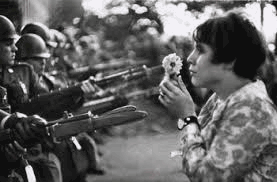
I will end with an old song and some new images.
Footnote: An excerpt from “Cold Turkey” by Kurt Vonnegut
About my own history of foreign substance abuse… I’ve been a coward about heroin and cocaine and LSD and so on, afraid they might put me over the edge. But I’ll tell you one thing: I once had a high that not even crack cocaine could match. That was when I got my first driver’s license! Look out, world, here comes Kurt Vonnegut.And my car back then, a Studebaker, as I recall, was powered, as are almost all means of transportation and other machinery today, and electric power plants and furnaces, by the most abused and addictive and destructive drugs of all: fossil fuels.
When you got here, even when I got here, the industrialized world was already hopelessly hooked on fossil fuels, and very soon now there won’t be any more of those. Cold turkey. Can I tell you the truth? I mean this isn’t like TV news, is it?
Here’s what I think the truth is: We are all addicts of fossil fuels in a state of denial, about to face cold turkey.
And like so many addicts about to face cold turkey, our leaders are now committing violent crimes to get what little is left of what we’re hooked on.